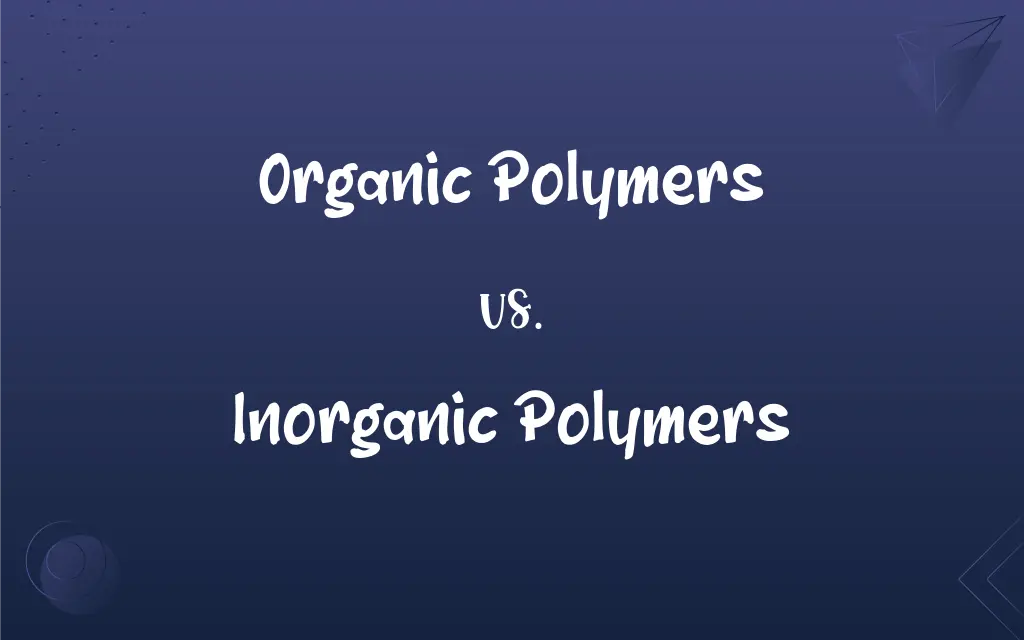Organic Polymers vs. Inorganic Polymers: What's the Difference?
Edited by Aimie Carlson || By Janet White || Published on August 15, 2024
Organic polymers are based on carbon chains, while inorganic polymers are composed of non-carbon elements or backbones.

Key Differences
Organic polymers consist of long chains of carbon atoms, making them the backbone of materials like plastics, rubbers, and fibers. These polymers are characterized by their carbon-based structures, which may include other elements such as hydrogen, oxygen, nitrogen, and sulfur. Inorganic polymers, in contrast, do not rely on carbon as their primary structural element. Instead, they are built from inorganic elements like silicon, phosphorus, and sulfur. These polymers exhibit unique properties such as high temperature resistance and chemical stability, making them suitable for specialized applications.
The properties of organic polymers are largely influenced by the nature of the carbon-carbon bonds within their chains. These bonds provide a versatile framework that can be modified to achieve a wide range of physical and chemical characteristics. Inorganic polymers, while less common than their organic counterparts, offer distinct advantages in certain applications due to their inorganic nature. Their structures can impart properties such as increased thermal stability, flame resistance, and unique electrical characteristics.
Organic polymers and inorganic polymers are distinguished by their respective carbon-based and non-carbon-based backbones, which dictate their properties and applications. Organic polymers are prevalent in a wide range of everyday materials, while inorganic polymers are sought after for their specialized properties in advanced technological applications.
Comparison Chart
Backbone Composition
Carbon chains
Non-carbon elements (e.g., silicon, phosphorus)
Common Examples
Polyethylene, Polystyrene
Silicones, Polysiloxanes
ADVERTISEMENT
Properties
Flexible, versatile, wide range of applications
High temperature resistance, chemical stability
Applications
Packaging, textiles, consumer goods
Sealants, electronics, aerospace
Chemical Resistance
Varies with composition
Generally high, especially to organic solvents
Organic Polymers and Inorganic Polymers Definitions
Organic Polymers
Characterized by covalent bonding of carbon atoms.
Polyvinyl chloride, or PVC, is an organic polymer used in pipes.
Inorganic Polymers
Known for their thermal and chemical stability.
Silicones are inorganic polymers used in high-temperature applications.
ADVERTISEMENT
Organic Polymers
Basis of synthetic plastics and rubbers.
Natural rubber is an elastic organic polymer used in tires.
Inorganic Polymers
Can exhibit unique electrical or optical properties.
Phosphazenes are inorganic polymers used in flame-retardant materials.
Organic Polymers
Can be naturally occurring or synthetic.
DNA is a complex organic polymer essential to life.
Inorganic Polymers
Often used in advanced technology and industrial applications.
Polysiloxanes, inorganic polymers, are used in sealants and adhesives.
Organic Polymers
Versatile materials with varied applications.
Polyester is an organic polymer popular in fabric production.
Inorganic Polymers
Composed of elements other than carbon.
Silica gel, an inorganic polymer, is used as a desiccant.
Organic Polymers
Carbon-based long molecular chains.
Polyethylene is a widely used organic polymer in packaging.
Inorganic Polymers
Less common but essential for specific uses.
Polyphosphazenes are inorganic polymers used in medical devices.
FAQs
How do inorganic polymers differ from organic polymers?
Inorganic polymers are based on non-carbon elements, such as silicon or phosphorus, offering unique properties like high temperature resistance.
Are organic polymers versatile in their applications?
Yes, organic polymers are extremely versatile, used in everything from packaging and textiles to automotive parts.
What are some common uses of inorganic polymers?
Inorganic polymers are used in sealants, electronics, aerospace, and medical devices due to their specialized properties.
What defines an organic polymer?
Organic polymers are defined by their carbon-based backbone and can include elements like hydrogen, oxygen, and nitrogen.
How do inorganic polymers exhibit chemical resistance?
Inorganic polymers often show high resistance to chemicals, especially organic solvents, due to their inorganic nature.
Can inorganic polymers be used in the medical field?
Yes, certain inorganic polymers are used in medical devices and implants due to their biocompatibility and stability.
How do inorganic polymers contribute to technology advancement?
Inorganic polymers contribute to technology by providing materials that withstand extreme conditions, useful in electronics and aerospace.
What is a key characteristic of organic polymers?
A key characteristic of organic polymers is their carbon-based structure, which allows for a wide range of properties and applications.
What environmental considerations are there for organic polymers?
Environmental considerations for organic polymers include their persistence in the environment and the challenges of recycling.
Can organic polymers be naturally occurring?
Yes, organic polymers can be both naturally occurring, like cellulose in plants, and synthetic, like nylon.
What makes inorganic polymers suitable for high-temperature applications?
The inorganic backbone of these polymers provides high thermal stability, making them suitable for high-temperature environments.
What role do organic polymers play in consumer goods?
Organic polymers are crucial in consumer goods, providing materials for clothing, packaging, household items, and more.
What future applications might inorganic polymers have?
Future applications for inorganic polymers could include new energy storage solutions, advanced coatings, and materials for space exploration.
Why are inorganic polymers less common than organic ones?
Inorganic polymers are less common due to their specialized synthesis processes and niche applications compared to the widespread use of organic polymers.
How do the electrical properties of inorganic polymers benefit electronics?
The unique electrical properties of some inorganic polymers, such as conductivity or insulation, make them valuable in electronic components.
What advancements have been made in organic polymer research?
Advances in organic polymer research include developing new polymers with enhanced strength, flexibility, and environmental friendliness.
What is the significance of synthetic organic polymers?
Synthetic organic polymers are significant for their tailor-made properties, allowing specific applications from lightweight materials to biodegradable plastics.
Are inorganic polymers customizable like organic polymers?
While customizable, inorganic polymers often have more limited modification options due to their inorganic nature and synthesis challenges.
How does the structure of organic polymers affect their properties?
The structure, particularly the arrangement and type of carbon bonds, greatly influences an organic polymer's properties like elasticity and strength.
What challenges exist in the production of organic polymers?
Challenges in producing organic polymers include managing environmental impact, resource use, and ensuring product consistency.
About Author
Written by
Janet WhiteJanet White has been an esteemed writer and blogger for Difference Wiki. Holding a Master's degree in Science and Medical Journalism from the prestigious Boston University, she has consistently demonstrated her expertise and passion for her field. When she's not immersed in her work, Janet relishes her time exercising, delving into a good book, and cherishing moments with friends and family.
Edited by
Aimie CarlsonAimie Carlson, holding a master's degree in English literature, is a fervent English language enthusiast. She lends her writing talents to Difference Wiki, a prominent website that specializes in comparisons, offering readers insightful analyses that both captivate and inform.






































































